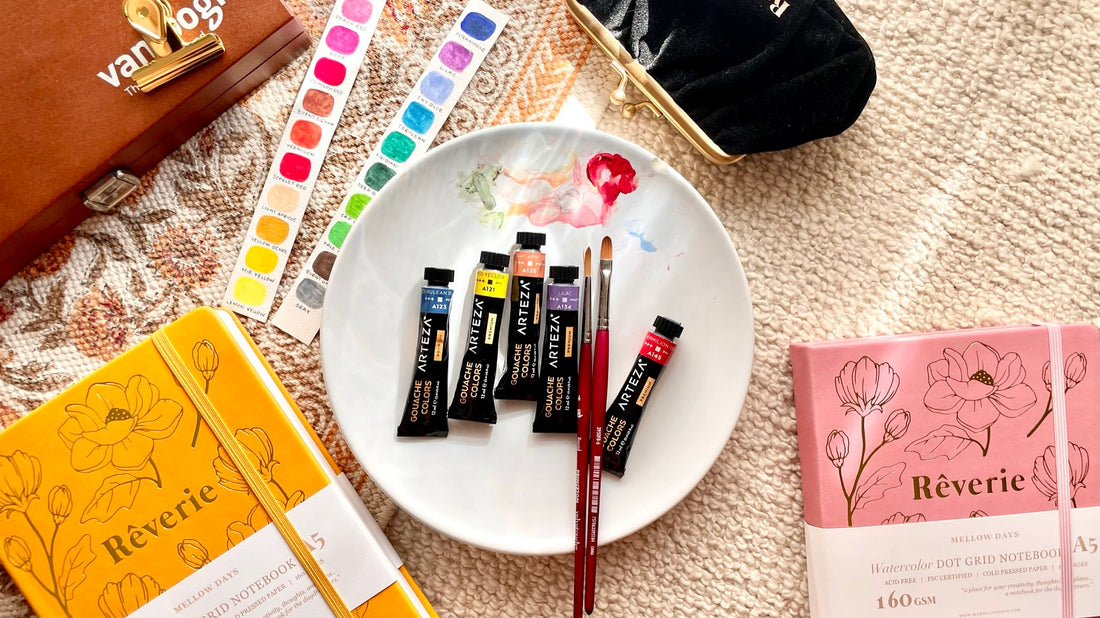
For Everyone Who Wants To Start Painting In Their Journal
Share
Do you want to start painting in your bullet journal, but don't know where to start?
I've been there too, and had to try some different journals before I found one that worked for me. Today I'm going to give you my thoughts, on what I should have been looking for, and some painting materials you might want to consider. This is my contribution to you, if you're new to painting in your journal. I hope my advice will help you in your painting journey. 😊 Let's start...
Tip 1 : Choose quality paper
Before making your first brushstroke, keep in mind you'll be using water. Most notebooks have thin paper, which aren't very good for art in general and that's even more true when it comes to painting. Of course that doesn't mean you can't use paint on thin paper. You will just have to be very careful about the amount of water you use. And be ready for possible surprises such has :
- Color bleed through to the back side of the paper
- You may not be able to use both sides of the page
- Thin paper tends to wrinkle and warp a lot
- Paper tears easily
- Pigment doesn't react as well as on art paper

My advice, use thicker paper.
It's easier now to find journals with thicker paper around 160gsm, while most journals have 90gsm. Paper at 160gsm is pretty thick, yet thin enough to be bound into a decent notebook with a good amount of pages (160 pages in general).
This thickness will allow you to use a bit more water and the paper is more resistant. However, thickness isn't everything, especialy if you want to use watercolor (or diluted gouache).
The type of paper is very important
You don't want a paper that's been too coated with "a finish" because your paints won't set correctly. The pigments might slide on the paper face and won't dry evenly. You don't want a paper that will absord the paint too quickly either, because then you wo't be able to blend your colors correctly.
I personally use my Rêverie Journal which has cold pressed paper. The texture on the pages makes it perfect for watercolor and paint.
Other than the Rêverie Journal you can take a look at Archer & Olive, Mossery, and Moleskine, who also have interesting dot grid journals.
Tip 2 : Which paint should you use
This is a question that I can't really answer because it will depend of your personal taste. But I can give you some suggestions 😊
Watersoluble Pastels
Thanks to the Neocolor II from Caran d'Ache I started painting again. I just found them so easy and fun to use. They are playful and I imagine it's slightly the same as using watercolor pencils. There are different ways to use them and if you are interested, here is my review.

The Most Versatile... Gouche Paint
Now I'm mostly use gouache. I find them more versatile than watercolor. You can easily get an opaque layer or can dilute the pigments to get something similar to watercolor. I first started with the Arteza gouache before to switch for my own.

What about Watercolor!
Most bujo artists prefer this type of paint. I don't use them as much but I really like the Van Gogh set that I have. The colors are vibrant and pigmented (and the wooden box is beautiful).
I have another set that's good for starting out, from Winsor & Newton, there are 46 half pan, so many colors! I found it few years ago at a very good price on Amazon.

Last but not least I also own a set of Coliro watercolor, with shimmery colors and gold. These are great for adding a hint of shine.

Tip 3 : My Most Used Paint Brush
If you don't have any paint brushes at home, I recommend to start with a round fine tip brush. One that's not too thick with a fine tip. I mostly use these for my paintings. I find they're versatile for painting details with the tip, and the sides for larger areas.
I don't think it's necessary to look for "professional" or very specific brushes in the beginning. Start with a small basic set. You don't want to spend too much money when you're not sure which brushes you really need. With time you'll be able to know the type of brushes you really need.

Some last tips!
- If your notebook has thin paper, add a small piece of cardboard or thick paper underneath the page you are working on, to protect the paper behind.
- Do a color swatch and test of your new paints in your journal (like on the last page of your notebook). This way you can see how the paper reacts to the paint, the water, and how the colors will look in your journal.
If you want to watch how I paint in my Rêverie Journal, you can watch here.